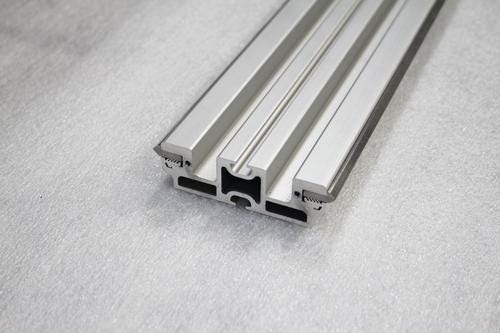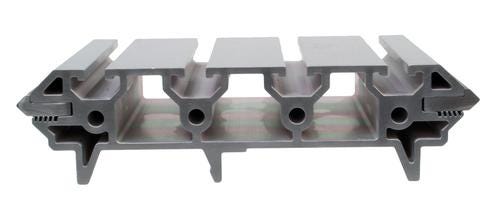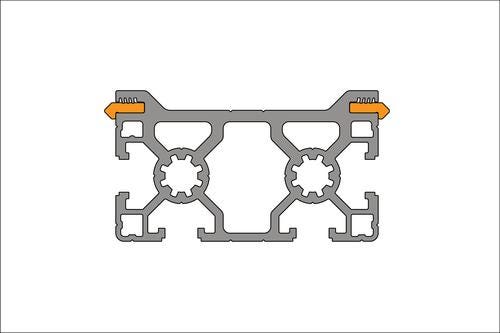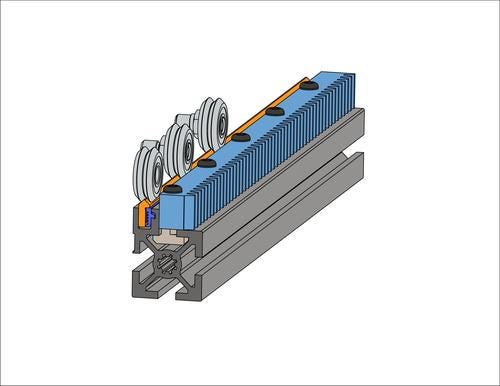September 2, 2015

[Editor's Note: This is the second part of how to design machine linear guides using extruded aluminum profiles, written by Bishop-Wisecarver's Brian Burke. To read Part 1 first, click here.]
Linear guides are one of the most important components required for the development of automated or computer-controlled equipment. They enable smooth and accurate motion for the primary machine functions and can be used on covers, guards, and equipment drawers. 3D printers, CNC routers, and tabletop factories wouldn't function without them.
Extruded-profile-based linear guides provide design freedom and can incorporate additional features to lower the overall complexity of a machine compared with standard linear guide products. There are many possible features that can be designed into a single extruded profile. Each feature can serve a variety of purposes. Most design features are functional and are intended to provide a means of attaching additional components. However, some features can be used simply for their form and to provide aesthetically pleasing shapes.

One example is to include small ripples, or ridges, on larger extruded surfaces to break up space and make it more pleasing to the eye. Some of the major useful design features that can be extruded into shape are outlined below.
Extruded Features: T-Slots
T-slots are useful. Their utility is self-evident. They have been used on machinery for more than a century. Vertical knee mills and CNC machines have t-slots on the working table surfaces for attaching a variety of fixtures and work pieces. T-nuts and bolts are used in the t-slots to attach material. Extruded t-slot features can be easily incorporated into a design, and they provide a means of attachment anywhere along the length of the extrusion.
T-slots can be used for attaching the extruded profile guide to a larger substrate such as a steel beam or a granite base. A t-slot feature can also be used to attach to other t-slots in the case where a machine is fabricated from t-slot profiles. Rubber feet, cable carriers, linear gear racks, covers, sheet metal brackets, and other mechanical components can be attached to t-slot features.

Extruded Features: Cavities
Aluminum extrusions are typically produced by an extrusion company and sold by the pound. The design of the tooling die is measured in total square inches of opening, enabling a simple calculation to determine the pounds per foot of the resulting product. Companies that provide the extrusion will have a minimum amount, measured in pounds or in linear length, to produce a batch of extrusion.
A minimum batch could have a wide variation in final linear length based upon the cross-sectional area of the tooling die. A profile with holes, voids, and thin sections will have a lower cross-sectional area and will be of lower weight per foot. These holes and internal shapes on the extrusion can serve useful purposes. In the case of linear motion applications, internal cavities can be used as a void for belt or chain returns, can hold internal wiring, or can be designed simply to reduce the weight.

Extruded Features: Holes
Round cavities, or other similar shapes can be included in the extrusion die design. These features are particularly useful when they are sized for secondary thread tapping. The ability to thread-tap an extrusion provides many possible benefits. The end threads can be used as attachment points for brackets and enable multi-axis gantry configurations.
Threaded holes can also be used for attaching end caps, end seals, or other finishing materials. In some applications, an extruded hole can be used to convey pressurized fluids or gas such as high-pressure air because the necessary fittings can be easily attached at these locations.
Extruded Features: Power Transmission
Extruded profile guides can be designed to incorporate specific areas for attaching power transmission components such as linear gear racks. Typically, a flat section of the extrusion is used with a small reference edge to simplify alignment. A secondary machining operation to add threaded holes down the linear length may be required for attaching the gear rack.
Other possible alternatives to attach the gear rack include using high-strength adhesives, or mounting over t-slot features. Integrating the location for gear rack attachment into the extrusion ensures that the vee guide surfaces are parallel to the power transmission components, making for a compact and simplified motion axis sub-assembly.

Extruded Features: Feedback
Another useful design feature for extruded profile guides is specific geometry for attaching linear tape encoders to provide position feedback to the machine control system. Similar to the attachment of gear racks for power transmission, a flat area with a reference edge can be incorporated for locating and adhering the linear tape encoder. The addition of an encoder will provide position feedback to the machine control system.
Extruded Features: Cable Carriers and Wire Ducts
Internal or external features can be incorporated for attaching cable carriers or wire ducting to simplify the electrical requirements of a machine. These features can be simple such as machined threaded holes, or can be complex such as extruded ripples for specific wire diameters. It is also possible to have a secondary extrusion attach to the primary extrusion to act as a wire duct lid.
Production Volumes
Initially it may sound prohibitive to source a custom, application specific extruded profile guide but the required minimum order quantities are much lower than most engineers expect. The minimum extrusion run is set at 100 meters, or about 330 feet of material. This would be too much material for a one time project, but for many machine build scenarios this minimum quantity is quite accommodating.
In the previous CNC router machine example that processes 4-by-8-foot plywood sheets requires around 20 linear feet. With a minimum amount of extrusion at 330 feet, and using 20 feet per machine build, only 16 machines can be made. Typical machine builders are working toward machine builds in lifetime quantities of several hundred. This is plenty of opportunity to consume the minimum amount of extrusion.
Linear guides are one of the critical components required for building automated and computer controlled machines. Most designers utilize standard linear guide products from existing manufactures, and as a result, must accept limited design freedom in their selection process. A new alternative is to design the right linear guide, with integrated features for simplified machine designs. Hardened steel 90-degree vee guide track can be incorporated using the finger retention method for providing smooth, debris-tolerant motion. Extruded profile guides are application specific, which helps to protect intellectual property and prohibits competitive pressures while securing the supply chain. They are supplied in low quantities and enable a lower total cost per machine.
ADDITIONAL READING: How to Regain Design Freedom in Machine Linear Guides, Part 1
 Click here to view Figure 7.
Click here to view Figure 7.
Brian Burke is a product manager at Bishop-Wisecarver, with more than 10 years of experience in the automation industry and extensive lean manufacturing knowledge. Bishop-Wisecarver Group is a woman-owned family of WBENC-certified companies and one of the most respected names in custom automation solutions and guided motion technology. BWC manufactures, stocks, and distributes guided motion components and systems for linear, rotary and curved track applications used worldwide in industries such as packaging, medical device manufacturing, wood processing, food processing, and semiconductor fabrication.
About the Author(s)
You May Also Like





